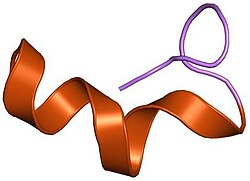Endothelin 1
Endothelin 1 (ET-1), also known as preproendothelin-1 (PPET1), is a potent vasoconstrictor peptide produced by vascular endothelial cells,[5] as well as by cells in the heart (affecting contractility) and kidney (affecting sodium handling).[6] The protein encoded by this gene – EDN1 – is proteolytically processed to release endothelin 1. Endothelin 1 is one of three isoforms of human endothelin.
Sources[edit]
Preproendothelin is precursor of the peptide ET-1. Endothelial cells convert preproendothelin to proendothelin and subsequently to mature endothelin, which the cells release.[5][7]
Clinical significance[edit]
Patients with salt-sensitive hypertension have higher plasma ET-1.[6] Endothelin-1 receptor antagonists (Bosentan) are used in the treatment of pulmonary hypertension.[5] Use of these antagonists prevents pulmonary arterial constriction and thus inhibits pulmonary hypertension.[5]
As of 2020, the role of endothelin-1 in affecting lipid metabolism and insulin resistance in obesity mechanisms was under clinical research.[8]
References[edit]
- ^ a b c GRCh38: Ensembl release 89: ENSG00000078401 – Ensembl, May 2017
- ^ a b c GRCm38: Ensembl release 89: ENSMUSG00000021367 – Ensembl, May 2017
- ^ "Human PubMed Reference:". National Center for Biotechnology Information, U.S. National Library of Medicine.
- ^ "Mouse PubMed Reference:". National Center for Biotechnology Information, U.S. National Library of Medicine.
- ^ a b c d Davenport AP, Hyndman KA, Dhaun N, Southan C, Kohan DE, Pollock JS, et al. (April 2016). "Endothelin". Pharmacological Reviews. 68 (2): 357–418. doi:10.1124/pr.115.011833. PMC 4815360. PMID 26956245.
- ^ a b Jankowich M, Choudhary G (2020). "Endothelin-1 levels and cardiovascular events". Trends in Cardiovascular Medicine. 30 (1): 1–8. doi:10.1016/j.tcm.2019.01.007. PMID 30765295.
- ^ Boulpaep EL, Boron WF (2009). Medical physiology: a cellular and molecular approach. Saunders/Elsevier. ISBN 978-1-4160-3115-4.
- ^ Jenkins HN, Rivera-Gonzalez O, Gibert Y, Speed JS (December 2020). "Endothelin-1 in the pathophysiology of obesity and insulin resistance". Obesity Reviews. 21 (12): e13086. doi:10.1111/obr.13086. PMC 7669671. PMID 32627269.
External links[edit]
- Overview of all the structural information available in the PDB for UniProt: P05305 (Endothelin-1) at the PDBe-KB.
This article incorporates text from the United States National Library of Medicine, which is in the public domain.






